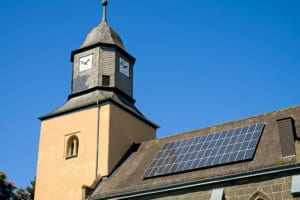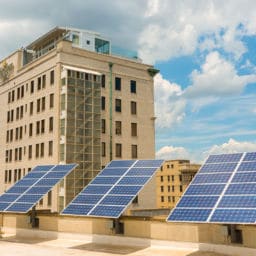The U.S. Nonprofit sector is filled with entities that occupy, and often, own commercial buildings, with ideal roof and parking space for solar power. With the U.S. Government phasing out cash grants, while extending tax credits for renewable energy projects, it is unlikely that many of these buildings will ever see a solar system on their roof, or in their parking lot. Given that the current Federal Investment Tax Credit (ITC) for renewable energy equates to 30% of the total eligible cost of a solar PV system, this is a substantial incentive that non-profits cannot take advantage of since they don’t pay federal income tax. The typical system suitable for the vast majority of these buildings ranges between 50 kW and 500 kW in size, with a small percentage needing systems larger than 1 MW.
 To demonstrate the magnitude of this problem, here are some numbers that show just how many buildings in the United States are currently unable to take advantage of the Federal ITC:
To demonstrate the magnitude of this problem, here are some numbers that show just how many buildings in the United States are currently unable to take advantage of the Federal ITC:
# of Churches in the U.S. – roughly 350,000 (as of 2010 census data)
# of Municipal buildings in the U.S. – roughly 20,000 municipal governments in the U.S. – if we assume each municipality has 5 government buildings, that’s about 100,000 total buildings
# of Public Schools – roughly 100,000 (as of 2010 census data)
Taking into account just these three categories of energy consumers, we are talking about over 550,000 buildings in the U.S. that cannot take advantage of the 30% ITC incentive. So, what’s being done about this? Let’s explore some different options:
-
- Operating Leases – Operating leases are common financial instruments that are often used to acquire expensive equipment such as vehicles, computing equipment and machinery. Operating leases allow the lessee to benefit from lessor owned assets, over a number of years (typically 5-10) using fixed payments. Since this is such a well-known product, many nonprofits have looked to leases as a possible option for adopting solar. However, due to tax, code, lessors are unable to capture the ITC while offering operating leases to..
- Loans –Loans, like operating leases allow borrowers to acquire assets over a number of years (typically 3-20 depending on the type of asset). However, because the borrower/owner is a nonprofit, this vehicle does not allow for the nonprofit to take advantage of the ITC. In addition, loans taken out to purchase solar systems reduce the amount of borrowing capacity of the borrower.
- Power Purchase Agreements (PPAs) – PPAs are agreements that allow energy consumers to consume solar energy with no money out of pocket, and in most cases allow energy consumers to take advantage of lower electricity bills from day 1. In this case, a third party owner buys and installs the solar system and sells that building owner electricity at rates lower than their current utility rates. This allows the third party owner (which is a tax paying entity) to monetize the ITC, and offer discounted electricity rates to the building owner.
Of these three options, PPAs have become the most popular financing vehicle for nonprofit entities for the reasons stated above. However, most companies that offer PPA financing do not offer financing for projects smaller than 1 MW, and almost none that will go below 500 kW.
Sustainable Capital (SCF) believes that this is a vast and very under supported part of the overall solar PV market. We offer PPA financing for projects as small as 100 kW and happily support nonprofit organizations. If you are a solar installer or a solar developer, please fill out our partner registration form to learn more.
About Sustainable Capital Finance: Sustainable Capital Finance (SCF) is a third party financier & owner/operator of commercial & industrial (C&I) solar assets and is comprised of experts that specialize in structured finance and solar development. SCF has a vast network of EPCs and Developers across the US that submit project development opportunities through SCF’s cloud-based platform, the “SCF Suite”. This allows SCF to acquire and develop early to mid-stage C&I solar projects, while aggregating them into large portfolios.


